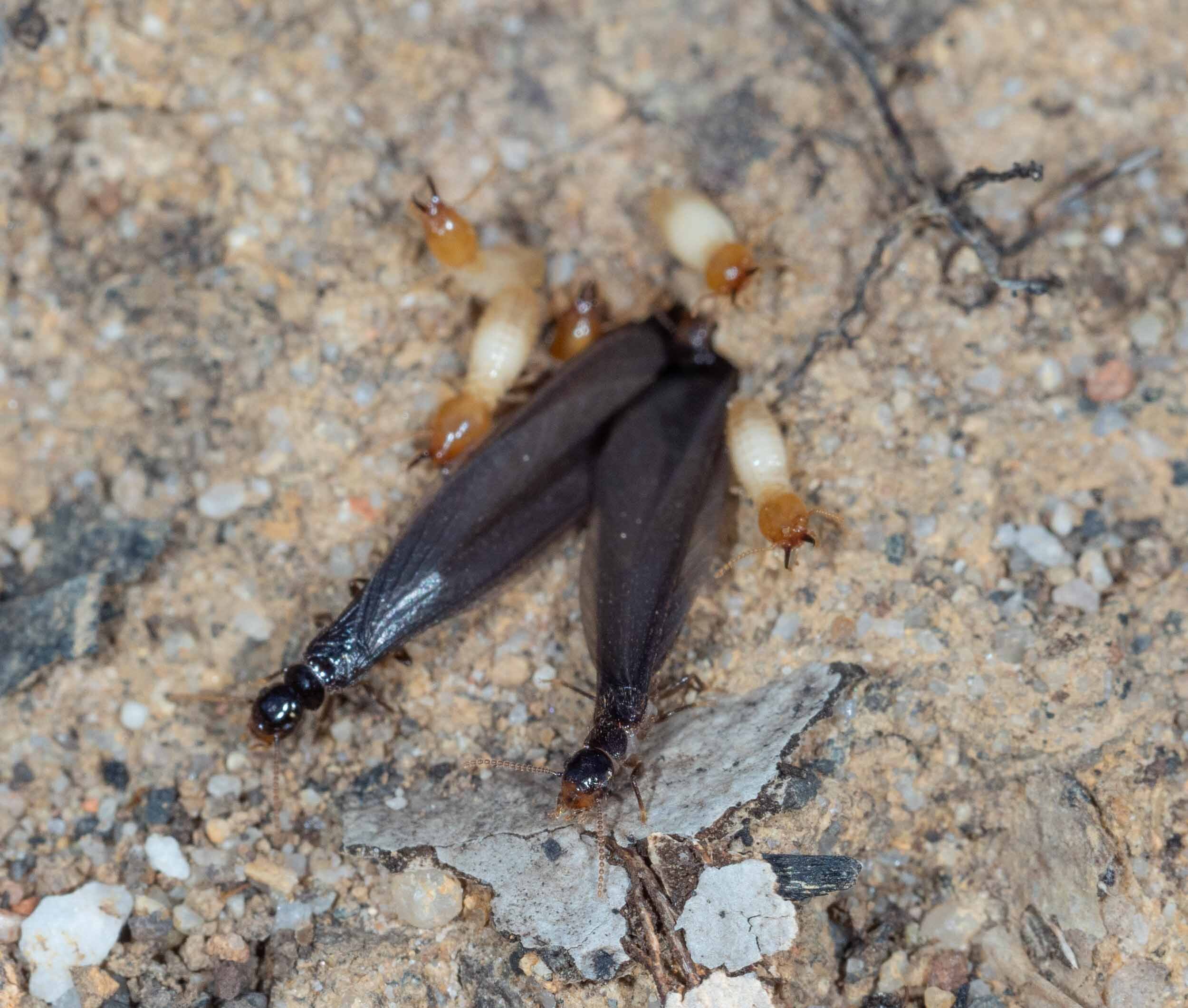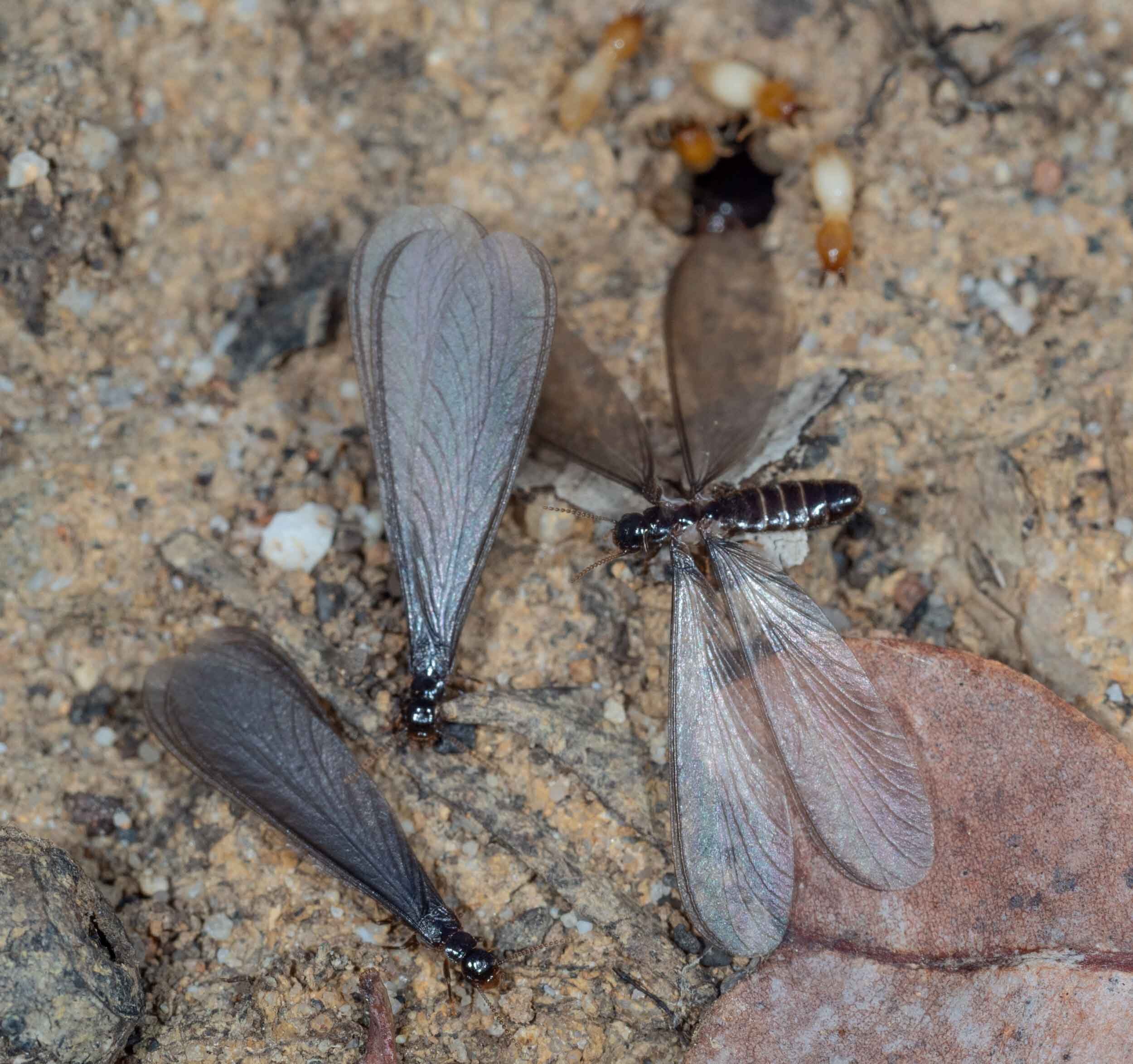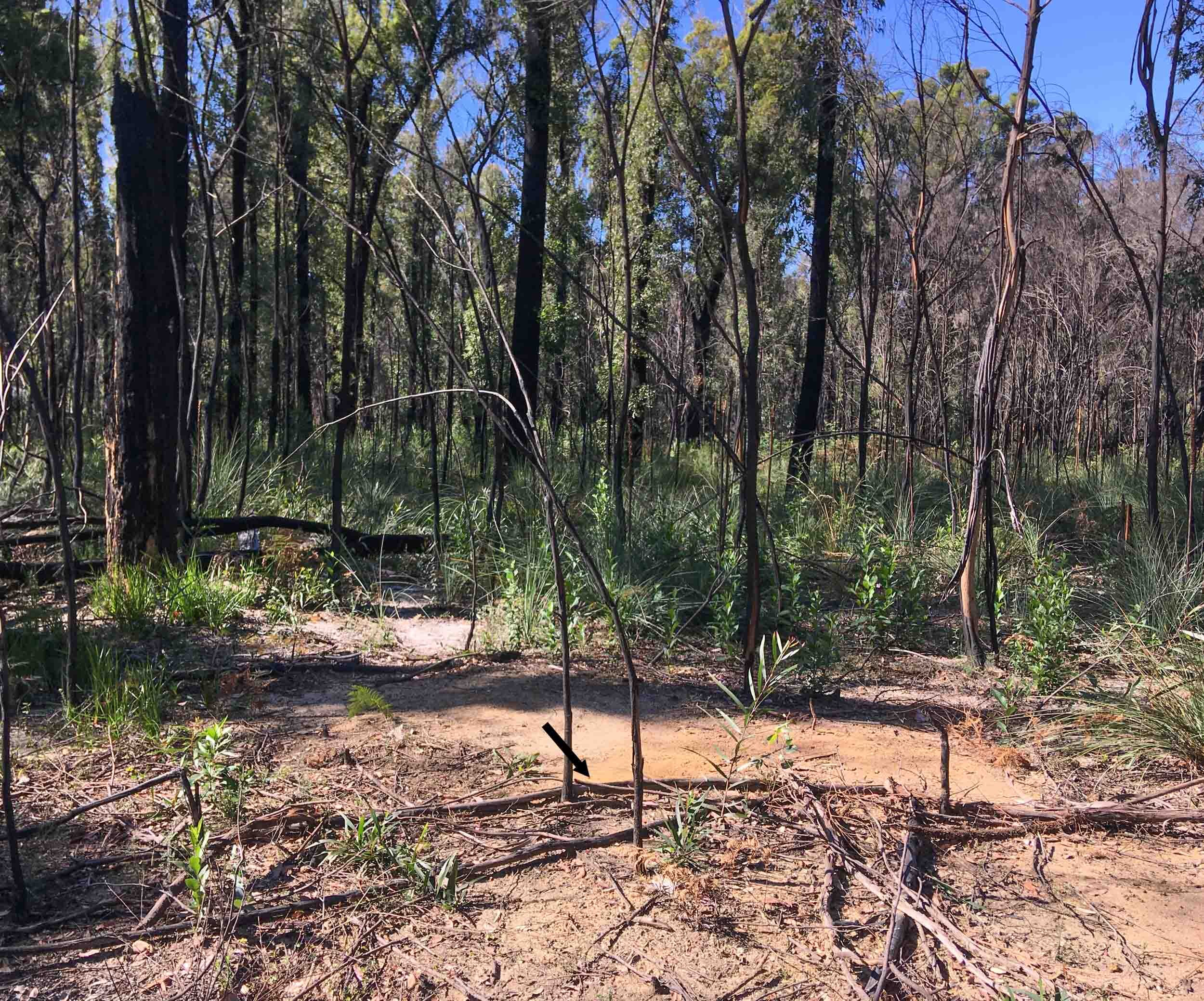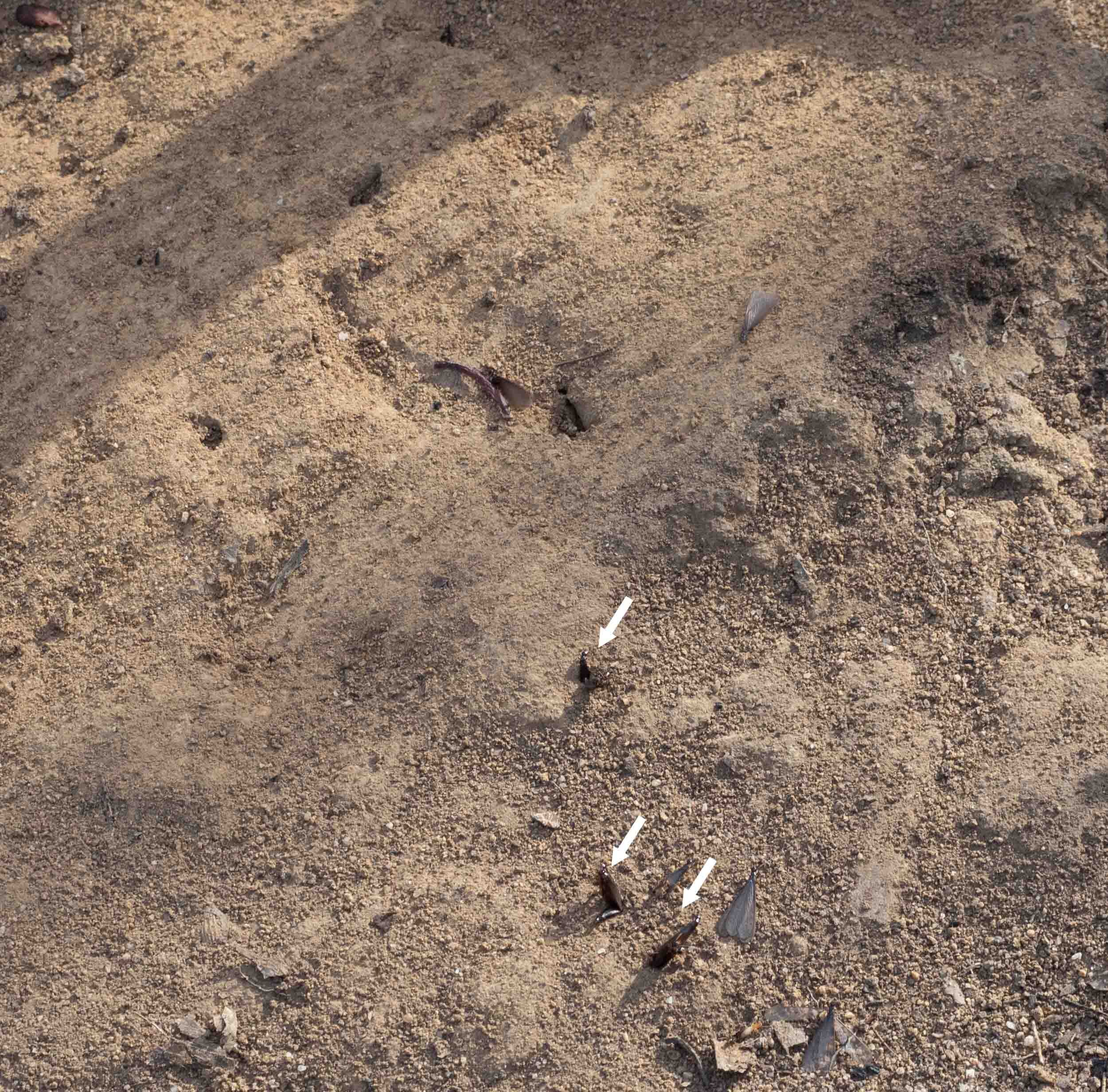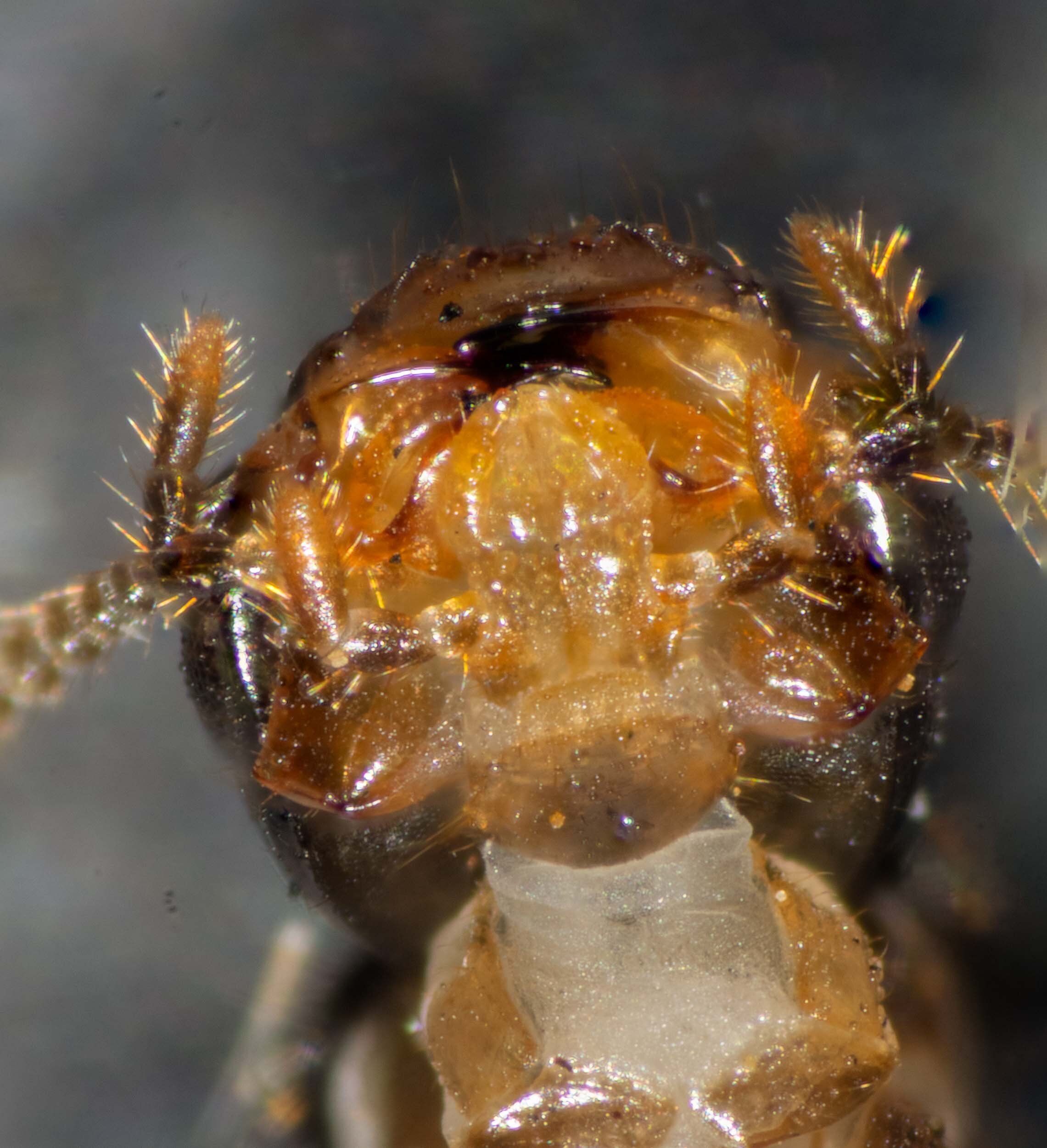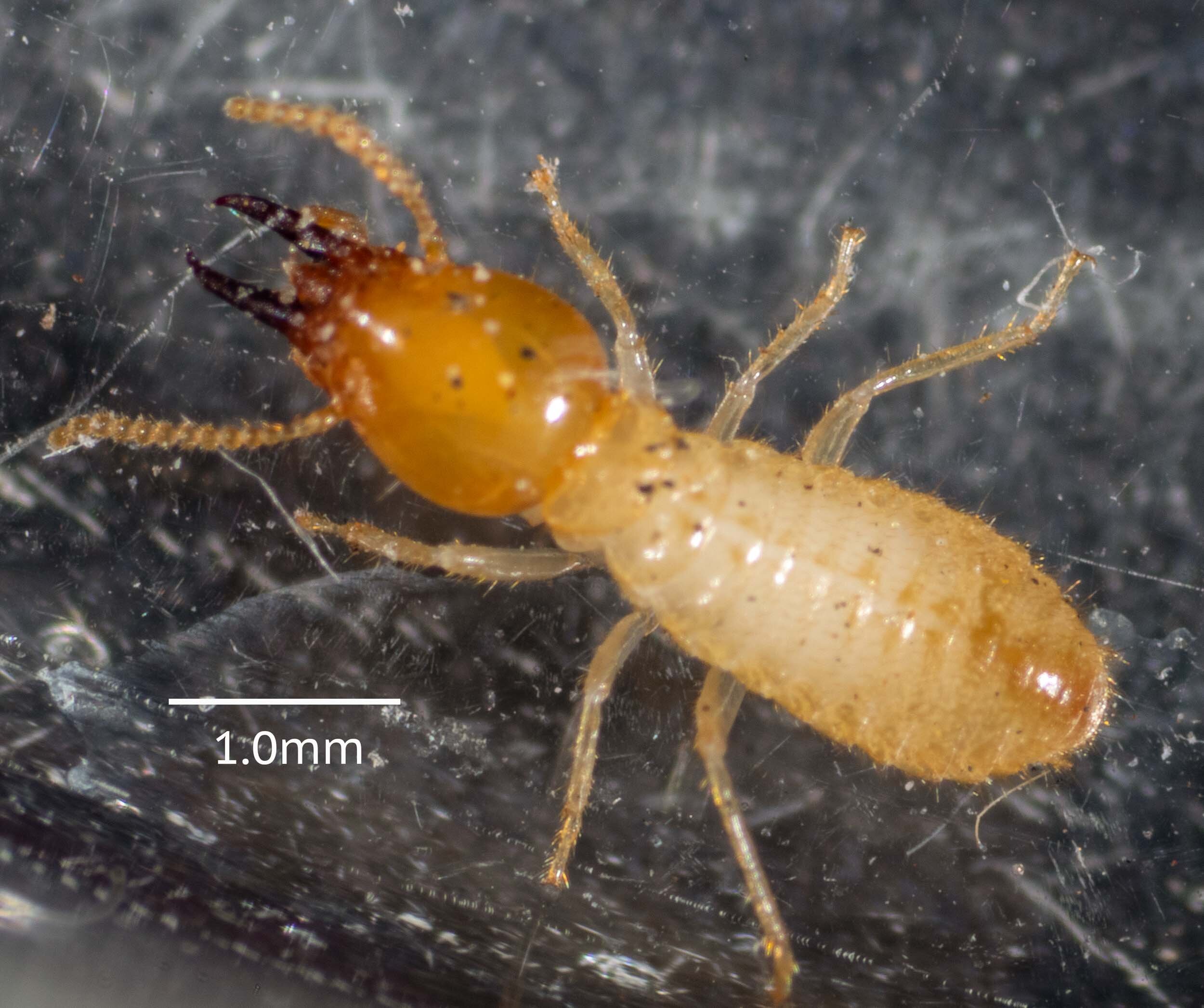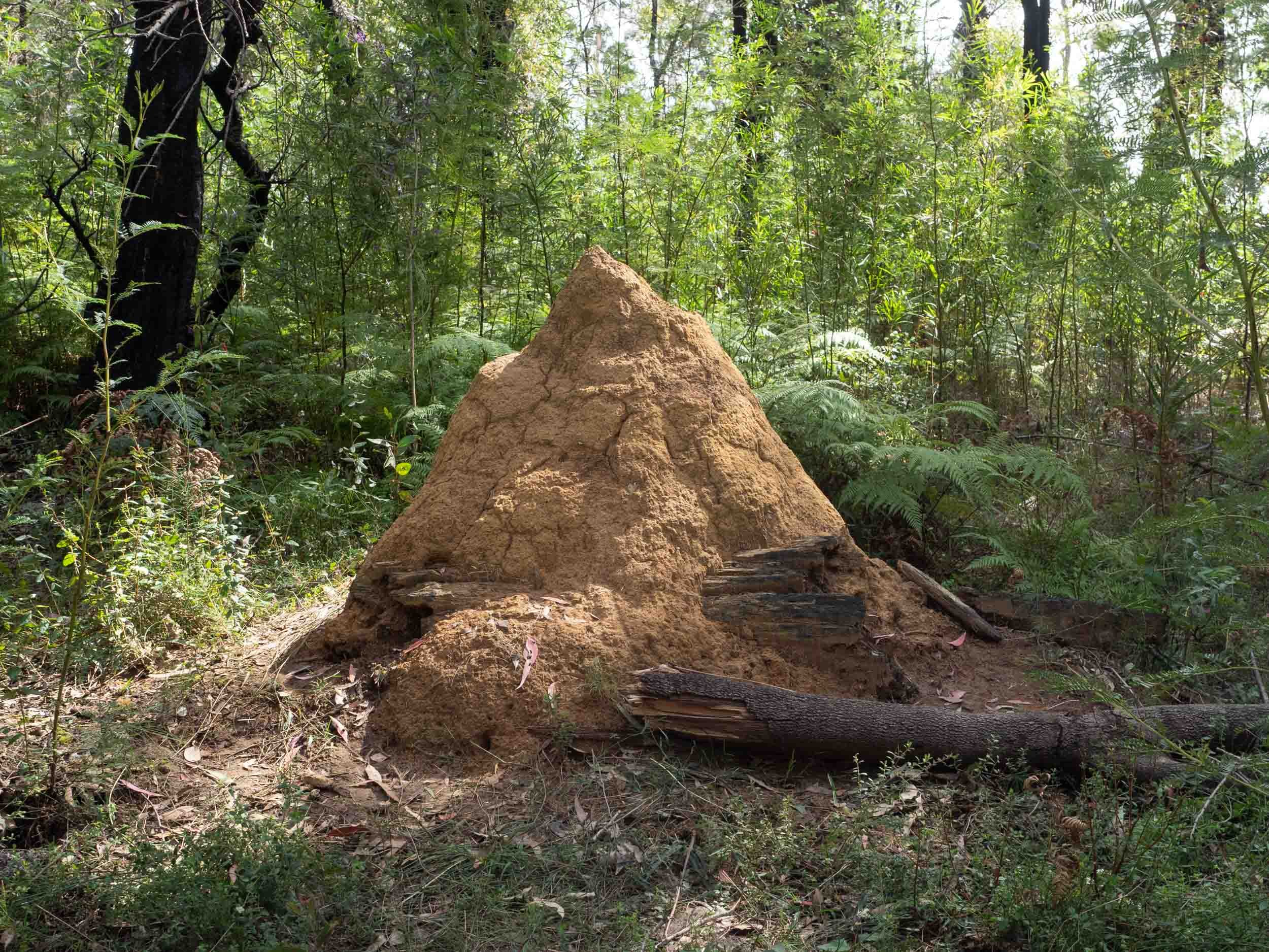The hidden millions
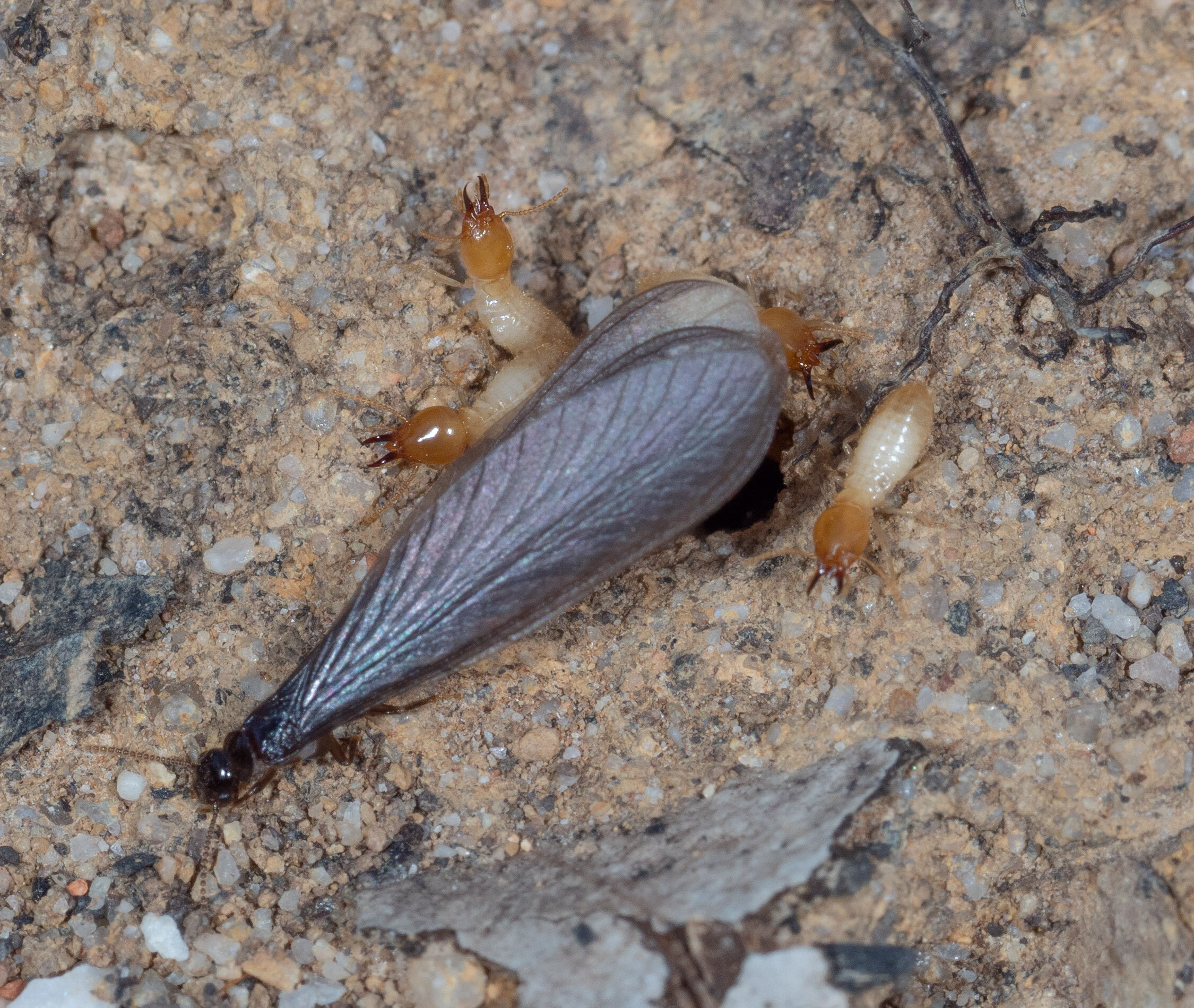
One of the first signs of the approaching Spring is the swarming of thousands of termites - a familiar event which will be repeated on several occasions over the following months. A few days ago we were fortunate to witness for the first time the start of the flight of the termites. This has prompted us to learn much more about termites and their hidden lives.
Swarming is a dispersal flight
In a previous post, we described what happens during a termite swarm.
The event is associated with a fall in barometric pressure and rise in temperature, as shown by this record of our weather station for the 3 days preceding the most recent swarm.
Barometric pressure over 72hrs preceding 8:00pm, 11th August
The first swarm of the season occurs at a remarkably consistent time - 22nd August in 2015; 16th August in 2016; 14th August in 2017; 11th August in 2018; 9th August in 2020; and 11th August this year.
Thousands of winged insects (alates) suddenly appear, seemingly out of nowhere. These are the adult reproductive forms and the swarms contain both males and females.
Their flight is slow and laboured. They soon drop to the ground, shed their wings and begin the pairing-up process. Males follow females in frenzied pursuit and the pair seeks out a suitable place to establish a new colony - usually a crevice in a log or stump.
They then excavate a space large enough to hold both of them, seal the opening and mate. We now have a new king and queen! They’ll stay there for the rest of their lives - which in some species may be up to 50 years for the queen. Their offspring will become the members of a new termite colony.
Those that succeed in this endeavor are certainly in the minority. Most termites are greedily taken by a wide range of predators - avian, reptile, arachnid, insect…you name it - soon after making ground. The swarms provide a significant energy input for the forest ecosystem - particularly those that occur early in the season, when food is in short supply.
The start of the journey
These flights must start from an existing termite colony. But where are these located?
Break open any old, large, rotting log in the forest and chances are you’ll discover termites and perhaps a small termite nest.
Many termite species make colonies in the trunks of large, living trees or the butts of felled or burnt trees.
The most obvious location for a termite colony is, however, a mound. We have a couple of these here in the forest.
I had always assumed that one of these mounds would be where we’d see the start of a termite flight, if ever.
Our latest swarm appeared at an unexpected, rather unprepossessing site - a flat patch of bare earth.
We chanced across this spot while wandering through the forest, mid-afternoon on 11th August. Our attention was drawn to a mass of jostling winged termites in an approx. 30x30cm patch of ground. Closer inspection revealed several holes in the surface of the hard-packed clay soil, each surrounded by a number of soldier termites.
Soldiers are one of the three termite castes, the other two being the reproductives and worker termites.
Workers and soldiers are blind, soft-bodied and have only a thin cuticle, being adapted for life in the dark, humid environment inside the colony. Alates on the other hand have a thick cuticle, compound eyes and a pair of simple eyes (ocelli), equipping them for their flight in the outside world and their search for a new colony site.
We watched alates regularly emerging from the holes in the ground, flapping around awkwardly then taking flight. The soldiers maintained their positions at the entrance as the alates departed, waving their heads with jaws extended menacingly into the air.
This video shows a series of alates emerging from a hole.
The swarm site is within a 7x4 metre area, which is covered by the same hard clay surface and is elevated slightly above the surrounding sandy soil. It is devoid of vegetation except for a few small seedlings of wattles (Acacia obtusifolia) and hop bushes (Dodonaea triquetra). There are also a few charred stems of low bushes - probably wattles - which were destroyed in the January 2020 fire which raced through the forest.
Five metres away is a 2 metre tall blackened trunk - the remnants of a large eucalypt tree which was almost completely destroyed in that fire. It shows obvious signs of previous termite activity under the bark which burnt away.
I returned to the site two days after the swarm and found no sign of either termites or exit holes at the site of emergence. Worker termites had presumably been busy filling in the holes.
I returned three days after that and scraped away the top centimetre or so of clay soil. This revealed several holes leading into galleries which headed further underground where the colony is located. More about that later…
Update: 20 August
Over the last 24 hours, the barometric pressure has dropped from 1022 to 1014 millibars while the temperature has risen quickly to 23°C. And predictably, we have another termite swarm!
Of course the first place I headed to was the spot where we saw the alates emerging on 11 August. Most of the galleries and holes I had exposed on 16 August had been filled in. But new holes were present with alates emerging from them.
Most of these holes were a tad undersized – several alates would be struggling to emerge at the same time, and they were getting trapped. Eventually they’d wriggle free but it took a few minutes.
Few soldiers were in attendance this time.
The event began at around the same time as the August 11th one – 3:00pm.
The air was soon thick with flying termites and many of them were landing and seeking out potential sites for establishing a colony. A burnt tree stump was a particular favourite, with its many cracks and fissures.
As the termites squeezed into the cracks their wings fell off. There is a special zone of weakness at the base of the wing to allow this dealation. You can see many of these discarded wings in the following video.
Male termites then immediately began pursuing the females. These tandem pairs showed quite stereotypic behaviour. She leads, investigating nooks and crannies – he tags along behind, probing her rear end with his mouthparts.
I collected a pair of termites and photographed them to show sexual differences. Females are longer than males and have a fatter abdomen with fewer terminal segments.
The stumps of the wings can be seen in the single female image. The wings break off reliably at this point where there is an abscission zone.
Who are these termites?
At the time of swarming, I collected a number of the alates and soldiers for later examination and species identification. Photo-matching to images of type specimens shown on the PaDIL website narrowed the search down to 2 candidates - Coptotermes lacteus and Coptotermes frenchi. The only other Coptotermes species that looks similar - C. acinaciformis - is considerably larger.
C. lacteus and C. frenchi are very similar in appearance and PaDIL provides little information on their differences. So I consulted a reference book which gives detailed descriptions of all species of Australian termites known at the time of publication (1942), their biology and their pest status (ref. 1).
I eventually settled on an identity of Coptotermes lacteus for our termites, based on the following characters (see also my iNaturalist observations of the alate and the soldier).
Alates:
Head and thorax very dark brown vs. cinnamon brown for C. frenchi
Abdominal tergites very dark brown vs. yellow for C. frenchi
Wings very dark brown vs. light fuscous for C. frenchi
Soldiers:
15 antennal segments - C. frenchi has 14
mandibles longer, narrower and more curved than C. frenchi
head larger, darker and narrower anteriorly than C. frenchi
The common name for Coptotermes lacteus is the Milk Termite. When disturbed soldiers often eject a milky drop of fluid from a gland on the front of the head. Kerri noticed these little pearly drops when she was collecting some soldiers in a vial.
What does a milk termite nest look like?
As I was unwilling to further excavate the area beneath the alate emergence site, I’ve used reports in the literature to give me a clue about the likely construction of the nest there.
Hill states that “the majority of Coptotermes species live in carton-like nests either in the soil (subterranean), or in the trunks of trees” (ref. 1).
‘Carton’ nests are made from the faeces of termites mixed with soil. This is a good construction material as it is rich in lignin, a rigid polysaccharide which is resistant to decay. The worker termites mould this into layers to produce large flattened cells arranged in a diffuse pattern - rather like cardboard.
This photo on the Australian Museum website shows the structure of a carton nest of a termite mound beneath its outer clay layer.
The nursery - housing the king, queen termites and their large brood of developing nymphs - lies at the centre of a carton nest. It has a similar structure to the outer layers except that the cells are mainly horizontal and thinner walled (ref. 1). This image from the Australian Museum website shows the structure of the nest around the queen.
So I imagine this is what the nest looks like under the emergence site.
This came as a major surprise. A flat piece of bare ground can be a termite “mound”! We often wondered why little grew here!
But what about those two mounds I mentioned earlier? It is likely they also house colonies of C. lacteus.
Coptotermes lacteus, along with two other Coptotermes species (C. acinaciformis and C. michaelseni – neither of which is found in our region) can build mounds in addition to subterranean nests. These mounds are very similar in appearance and size to published photos of mounds of this species and larger than those of other local mound-building termites such as Eutermes exitiosus (ref. 1).
The forest is clearly home to many termites
Termite colonies can house huge numbers of insects. Roisin and Lenz cite earlier studies reporting that nests of C. lacteus can contain up to 1.1 million individuals (ref. 2). Worker termites forage for wood around the nest using underground runways. They therefore seldom need to come to the surface - “hidden millions”!
Milk termites have an undeservedly bad reputation
C. lacteus is often mistaken for the related C. acinaciformis. While having a similar appearance, these species differ substantially in one important aspect of their behaviour – C. acinaciformis has a taste for seasoned timber.
“In and around Sydney, it is the principal if not the only species of economic importance…Included in its activities is the destruction of bridge and wharf timbers, buildings, fences, poles, lead sheathing of subterranean electric cable, wooden sewerage pipes, commercial fruit-bearing plants, etc. etc.” (ref. 1) - ouch!
C. lacteus on the other hand is probably just a bit player when it comes to building damage. Although it sometimes damages poles, fences and buildings in suburban and country localities, is is more often found in logs, stumps and nests in open forest country. (ref. 1).
Footnote: Species identification matters!
Termites are eusocial cockroaches
So now we know who our termite is. But where do termites fit in the larger scheme of things? Who are their closest insect relatives?
Their common name of “white ants” is totally misleading of course. Termites have little in common with the order Hymenoptera (ants, wasps and bees) - beyond the fact they have an exoskeleton, six legs, one pair of antennae and a few other insect bits and bobs.
It has long been recognised that termites are closely related to cockroaches. And a genus of cockroaches called Cryptocercus is known whose nymphs look like termite nymphs, eats wood and, like termites, uses symbiotic gut protozoans to digest that wood. But those similarities could just reflect convergent evolution. Are they truly related?
We now know that termites are indeed cockroaches. The evidence came from a series of molecular studies in the mid 2000s, which compared sequences of mitochondrial and nuclear genes in different species (ref. 3). These showed conclusively that cockroaches are the closest relatives of termites, and that Cryptocercus is the sister group of termites, i.e. termites evolved from a Cryptocercus ancestor.
Relationships between termites and various families of cockroaches as demonstrated by comparison of sequences of five genes (ref. 3). Images of representative genera for each family are shown.
Image 1. by simono (CC BY-NC 4.0). Image 3. by Stefan Gleissberg, cropped (CC BY-NC 4.0). Image 5. by RattyExplores, cropped (CC BY-NC 4.0). Image 6. by Reiner Richter, cropped (CC BY-NC 4.0). Images 2, 4, 7. our own images taken here in the forest.
So termites are just social cockroaches. Until a decade or so ago, they had their own order (Isoptera) but they are now placed in the same order as cockroaches (Blattodea). In fact, some cockroaches - in the family Blattidae - are more closely related to termites than to other cockroaches.
Termites play a key role in ecosystems
Termites have a fearsome reputation as destructive pests. Google ‘termite’ and most of your top hits will be pest control companies.
But only 20 or so of the 267 recognised Australian species cause major economic losses (ref. 4).
Few species damage sound heartwood, either in trees or in building timber. Most eat wood on living trees that is either decayed or rotten, tree stumps or fallen branches and logs.
Some termite families consume plant “rubbish” - dead leaves, twigs, flowers that have dropped from forbs and bushes.
All of this activity plays a key role in recycling nutrients in ecosystems.
Termites are good for the environment!
References
Hill, G.F. (1942). Termites (Isoptera) from the Australian Region. Council for Scientific and Industrial Research. Melbourne.
Roisin, Y. and Lenz, M. (1999) Caste developmental pathways in colonies of Coptotermes lacteus (Froggatt) headed by primary reproductives (Isoptera, Rhinotermitidae). Insectes Sociaux 46, 273-280.
Inward, D., G. Beccaloni and P. Eggleton. (2007) Death of an order: a comprehensive molecular phylogenetic study confirms that termites are eusocial cockroaches. Biology Letters 3: 331-335
Australian Faunal Directory https://biodiversity.org.au/afd/taxa/Termitoidae











